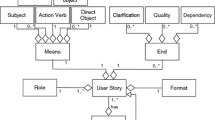Abstract
[Context and motivation] In agile system development methods, product backlog items (or tasks) play a prominent role in the refinement process of software requirements. Tasks are typically defined manually to operationalize how to implement a user story; tasks formulation often exhibits low quality, perhaps due to the tedious nature of decomposing user stories into tasks. [Question/Problem] We investigate the process through which user stories are refined into tasks. [Principal ideas/results] We study a large collection of backlog items (N = 1,593), expressed as user stories and sprint tasks, looking for linguistic patterns that characterize the required feature of the user story requirement. Through a linguistic analysis of sentence structures and action verbs (the main verb in the sentence that indicates the task), we discover patterns of labeling refinements, and explore new ways for refinement process improvement. [Contribution] By identifying a set of 7 elementary action verbs and a template for task labels, we make first steps towards comprehending the refinement of user stories to backlog items.
Access this chapter
Tax calculation will be finalised at checkout
Purchases are for personal use only
Similar content being viewed by others
Notes
- 1.
The individual tags refer to the Penn Treebank tagset [11].
References
Lucassen, G., Dalpiaz, F., Werf, J.M.E.M., Brinkkemper, S.: The use and effectiveness of user stories in practice. In: Daneva, M., Pastor, O. (eds.) REFSQ 2016. LNCS, vol. 9619, pp. 205–222. Springer, Cham (2016). https://doi.org/10.1007/978-3-319-30282-9_14
Kassab, M.: The changing landscape of requirements engineering practices over the past decade. In: Proceedings of EmpiRE, pp. 1–8 (2015)
Berry, D.M., Kamsties, E., Krieger, M.M.: From contract drafting to software specification: linguistic sources of ambiguity. Technical report, School of Computer Science, University of Waterloo, Canada (2001)
Bano, M.: Addressing the challenges of requirements ambiguity: a review of empirical literature. In: Proceedings of EmpiRE, pp. 21–24 (2015)
Rosadini, B., et al.: Using NLP to detect requirements defects: an industrial experience in the railway domain. In: Proceedings of REFSQ, pp. 344–360 (2017)
Lucassen, G., Robeer, M., Dalpiaz, F., van der Werf, J.M.E.M., Brinkkemper, S.: Extracting conceptual models from user stories with visual narrator. Requir. Eng. 22(3), 339–358 (2017)
Yue, T., Briand, L.C., Labiche, Y.: A systematic review of transformation approaches between user requirements and analysis models. Requir. Eng. 16(2), 75–99 (2011)
Bakar, N.H., Kasirun, Z.M., Salleh, N.: Feature extraction approaches from natural language requirements for reuse in software product lines: a systematic literature review. J. Syst. Softw. 106, 132–149 (2015)
Wautelet, Y., Heng, S., Kolp, M., Mirbel, I.: Unifying and extending user story models. In: Jark, M., et al. (eds.) CAiSE 2014. LNCS, vol. 8484, pp. 211–225. Springer, Cham (2014). https://doi.org/10.1007/978-3-319-07881-6_15
Lucassen, G., Dalpiaz, F., van der Werf, J.M.E.M., Brinkkemper, S.: Improving agile requirements: the quality user story framework and tool. Requir. Eng. 21(3), 383–403 (2016)
Marcus, M.P., Marcinkiewicz, M.A., Santorini, B.: Building a large annotated corpus of English: the Penn treebank. Comput. Linguist. 19(2), 313–330 (1993)
Jones, C.: Strategies for managing requirements creep. Computer 29(6), 92–94 (1996)
Schuler, K.K.: VerbNet: a broad-coverage, comprehensive verb Lexicon. Ph.D. thesis, Philadelphia, PA, USA (2005). AAI3179808
Author information
Authors and Affiliations
Corresponding authors
Editor information
Editors and Affiliations
Rights and permissions
Copyright information
© 2019 Springer Nature Switzerland AG
About this paper
Cite this paper
Müter, L., Deoskar, T., Mathijssen, M., Brinkkemper, S., Dalpiaz, F. (2019). Refinement of User Stories into Backlog Items: Linguistic Structure and Action Verbs. In: Knauss, E., Goedicke, M. (eds) Requirements Engineering: Foundation for Software Quality. REFSQ 2019. Lecture Notes in Computer Science(), vol 11412. Springer, Cham. https://doi.org/10.1007/978-3-030-15538-4_7
Download citation
DOI: https://doi.org/10.1007/978-3-030-15538-4_7
Published:
Publisher Name: Springer, Cham
Print ISBN: 978-3-030-15537-7
Online ISBN: 978-3-030-15538-4
eBook Packages: Computer ScienceComputer Science (R0)




